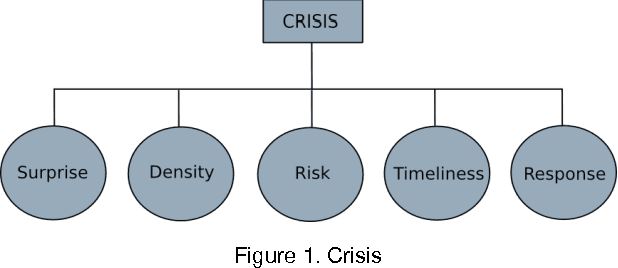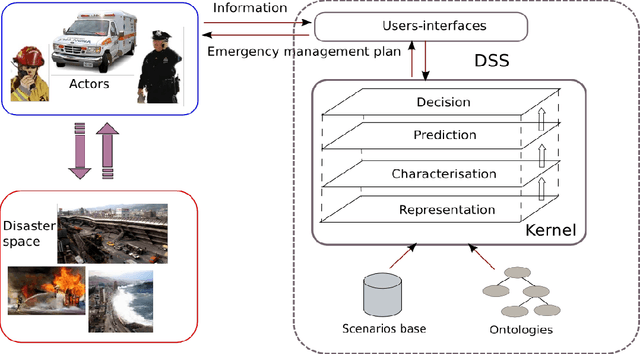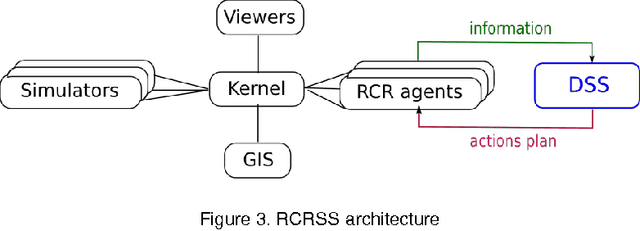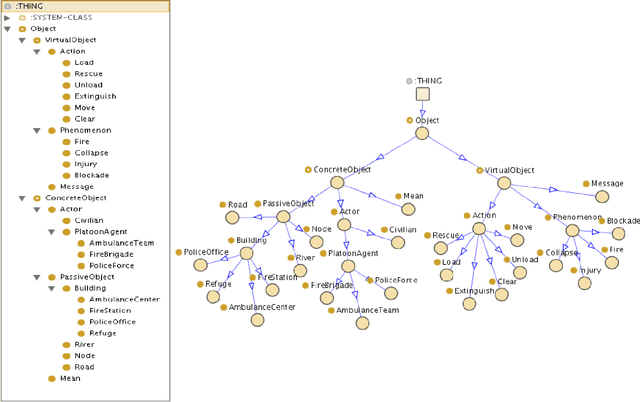Fahem Kebair
LITIS
Towards a Multiagent Decision Support System for crisis Management
May 31, 2014



Abstract:Crisis management is a complex problem raised by the scientific community currently. Decision support systems are a suitable solution for such issues, they are indeed able to help emergency managers to prevent and to manage crisis in emergency situations. However, they should be enough flexible and adaptive in order to be reliable to solve complex problems that are plunged in dynamic and unpredictable environments. The approach we propose in this paper addresses this challenge. We expose here a modelling of information for an emergency environment and an architecture of a multiagent decision support system that deals with these information in order to prevent and to manage the occur of a crisis in emergency situations. We focus on the first level of the system mechanism which intends to perceive and to reflect the evolution of the current situation. The general approach and experimentations are provided here.
* 14 pages. arXiv admin note: text overlap with arXiv:0907.0499
Agent-Oriented Approach for Detecting and Managing Risks in Emergency Situations
Jul 03, 2009



Abstract:This paper presents an agent-oriented approach to build a decision support system aimed at helping emergency managers to detect and to manage risks. We stress the flexibility and the adaptivity characteristics that are crucial to build a robust and efficient system, able to resolve complex problems. The system should be independent as much as possible from the subject of study. Thereby, an original approach based on a mechanism of perception, representation, characterisation and assessment is proposed. The work described here is applied on the RoboCupRescue application. Experimentations and results are provided.
Information Modeling for a Dynamic Representation of an Emergency Situation
May 27, 2009



Abstract:In this paper we propose an approach to build a decision support system that can help emergency planners and responders to detect and manage emergency situations. The internal mechanism of the system is independent from the treated application. Therefore, we think the system may be used or adapted easily to different case studies. We focus here on a first step in the decision-support process which concerns the modeling of information issued from the perceived environment and their representation dynamically using a multiagent system. This modeling was applied on the RoboCupRescue Simulation System. An implementation and some results are presented here.
Agent-Based Decision Support System to Prevent and Manage Risk Situations
Apr 20, 2009



Abstract:The topic of risk prevention and emergency response has become a key social and political concern. One approach to address this challenge is to develop Decision Support Systems (DSS) that can help emergency planners and responders to detect emergencies, as well as to suggest possible course of actions to deal with the emergency. Our research work comes in this framework and aims to develop a DSS that must be generic as much as possible and independent from the case study.
Towards an Intelligent System for Risk Prevention and Management
Apr 20, 2009Abstract:Making a decision in a changeable and dynamic environment is an arduous task owing to the lack of information, their uncertainties and the unawareness of planners about the future evolution of incidents. The use of a decision support system is an efficient solution of this issue. Such a system can help emergency planners and responders to detect possible emergencies, as well as to suggest and evaluate possible courses of action to deal with the emergency. We are interested in our work to the modeling of a monitoring preventive and emergency management system, wherein we stress the generic aspect. In this paper we propose an agent-based architecture of this system and we describe a first step of our approach which is the modeling of information and their representation using a multiagent system.
* 11 pages
Agent-Based Perception of an Environment in an Emergency Situation
Apr 03, 2008



Abstract:We are interested in the problem of multiagent systems development for risk detecting and emergency response in an uncertain and partially perceived environment. The evaluation of the current situation passes by three stages inside the multiagent system. In a first time, the situation is represented in a dynamic way. The second step, consists to characterise the situation and finally, it is compared with other similar known situations. In this paper, we present an information modelling of an observed environment, that we have applied on the RoboCupRescue Simulation System. Information coming from the environment are formatted according to a taxonomy and using semantic features. The latter are defined thanks to a fine ontology of the domain and are managed by factual agents that aim to represent dynamically the current situation.
Multiagent Approach for the Representation of Information in a Decision Support System
Mar 25, 2008



Abstract:In an emergency situation, the actors need an assistance allowing them to react swiftly and efficiently. In this prospect, we present in this paper a decision support system that aims to prepare actors in a crisis situation thanks to a decision-making support. The global architecture of this system is presented in the first part. Then we focus on a part of this system which is designed to represent the information of the current situation. This part is composed of a multiagent system that is made of factual agents. Each agent carries a semantic feature and aims to represent a partial part of a situation. The agents develop thanks to their interactions by comparing their semantic features using proximity measures and according to specific ontologies.
 Add to Chrome
Add to Chrome Add to Firefox
Add to Firefox Add to Edge
Add to Edge